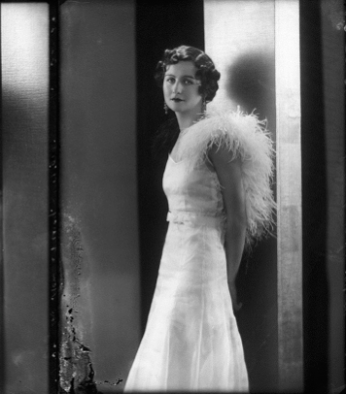“Isn’t it awful to love clothes as much as I do, you know, I am not vain at all,” Nancy complained to her mother, Lady Redesdale. Two decades before Nancy could afford the grandees of Parisian couture, she improvised with a modest wardrobe and a vast imagination. She had a knack for modifying her outfits to suit whichever setting she was in. In town, Nancy preferred tailored velvet tops and long wool skirts. In the country, she wore a tweed suit, the jacket of which was slung over a fitted blouse, or jumper. Nancy was tall and slim-the perfect recipe for high fashion.

In her youth, Nancy pushed the boundaries of what was deemed acceptable. She stained her skin with coffee beans and shingled her hair. Her dramatic features of black hair and green eyes singled her out from her fair haired siblings. When socializing, she preferred bias cut gowns, but bemoaned the ragged appearance of her old fur coat. “Really, I leave it everywhere, I long for the insurance money,” she quipped.
Post 1945 and reaping the success from The Pursuit of Love, Nancy found herself in liberated Paris, residing in a spacious flat on the rue Monsieur. She needed a wardrobe to go along with the lifestyle. “The English are hopeless at fashion,” she teased, provoking a violent response from British designers, “I admired a suit in a smart London shop,” she began, “the jacket of which was lovely, but the skirt…quite impossible.” Indeed, in her essay Chic-English, French & American, she expressed her disappointment in English fashion. An English Duchess, she explained, would never be in the height of fashion, that, she concluded, was, “Too eccentric,” and awfully bad manners. In England, high fashion was for starlets and harlots. A gentleman, she said, would have the social grace to wear his new suit around the garden before debuting it in the office. And American fashion…too vulgar.

Oddly, given her attitudes on American culture, Nancy was fascinated with American fashion. The children, she thought, looked like miniature adults with their pristine wardrobes and endless supply of clothing, and the women, quite peculiar in their updated versions of their daughter’s clothing. Their bright smiles, perfect teeth and poodle skirts-the less said about that, the better. She quickly leapt onto the topic of Parisian women.
Oh yes, Parisian women, to Nancy, were the best dressed in the world. But where could one see such a display of good taste? Certainly not on the streets of Paris, Nancy advised, for Parisian women were rarely seen in public, they spent their daily lives entering and exiting private cars, attending discreet luncheons and frequenting exclusive salons to view seasonal collections. They did not trudge the streets clad in Dior. Unlike London, where nobody aspired to be fashionable. The Londoners, Nancy explained, were out of step with Paris fashions, and by the time the latest trends reached London, Paris was already two years ahead. To her, it was an unrivaled competition. The French did it better.

As the sixties approached, Nancy gradually introduced shift dresses to her wardrobe. However, she loathed the long, bedraggled hairstyles the young people were sporting in London, “It might be pretty if they brushed it,” she said. Always a follower of fashion, Diana asked Nancy if she would rather be dowdy or ridiculous? “Oh,” Nancy replied,”ridiculous, of course.”




